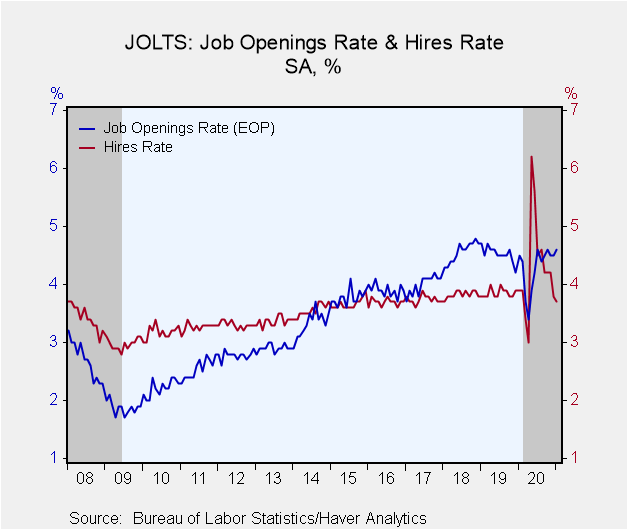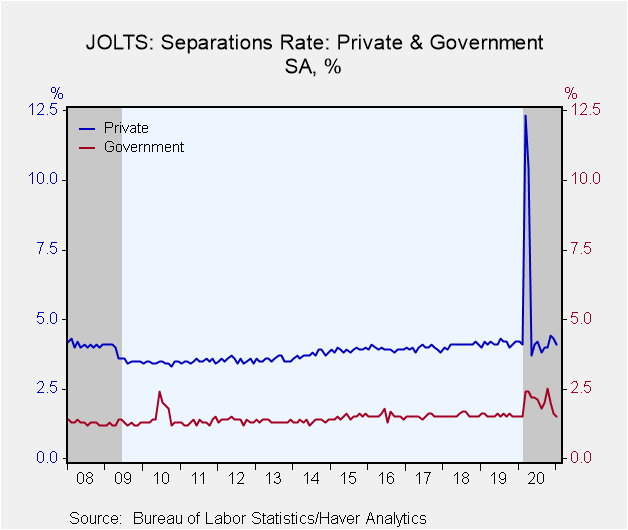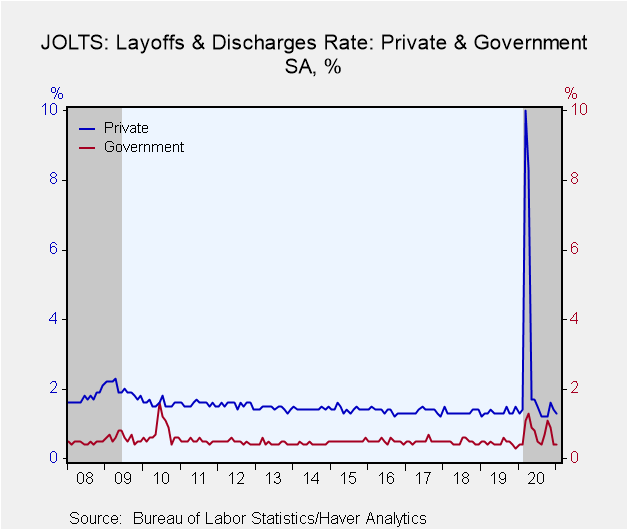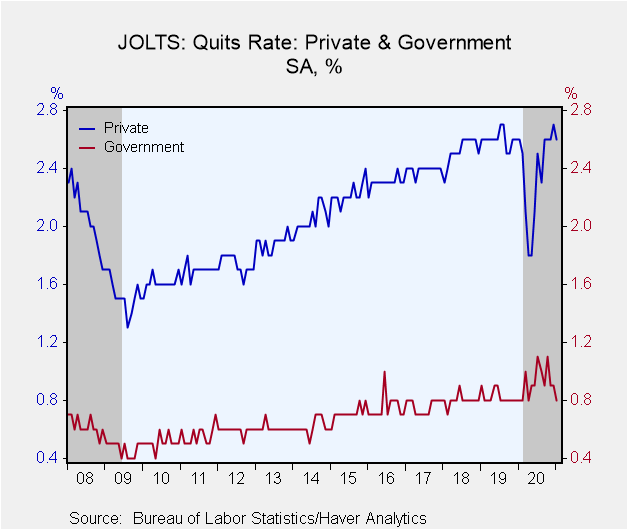 Global| Mar 11 2021
Global| Mar 11 2021U.S. JOLTS: Job Openings Rate Increases in January but Hiring Rate Declines
by:Tom Moeller
|in:Economy in Brief
Summary
• Both the job openings rate & the number of openings improve slightly. • Hiring activity continues to weaken. • Layoffs & quits ease. The Bureau of Labor Statistics reported that on the last business day of January, the total job [...]
• Both the job openings rate & the number of openings improve slightly.
• Hiring activity continues to weaken.
• Layoffs & quits ease.
The Bureau of Labor Statistics reported that on the last business day of January, the total job openings rate rose to 4.6% from an unrevised 4.5%. It was the highest level in three months. The openings rate is calculated as job openings as a percent of total employment plus jobs that have not yet been filled. The January figure remained below the 4.7% record in January 2019. The hiring rate fell to 3.7%, its lowest level since April of last year. The overall layoff & discharge rate eased to 1.2% and reversed its November increase to 1.5%. The quits rate rose eased to 2.3% and has been moving sideways for six months. These figures date back to December 2000.
The private-sector job openings rate rose to 4.9%. It remained below the record rate of 5.1% reached in November 2018. The professional & business services rate eased to 6.2% and the leisure & hospitality rate slipped to 5.3%. The government sector job openings rate edged higher to 3.1%. The job openings level rose 2.4% (-3.3% y/y) to 6.917 million.
In January, the hiring rate fell to 3.7%, remaining well below the record 6.2% in May. The private sector hiring rate eased to 4.1%. The government sector hiring rate held steady at 1.6%, down from 2.6% in August. The factory sector hiring rate fell sharply to 2.9%. The leisure & hospitality rate jumped to 7.0%. The professional & business service sector hiring rate eased to 5.0%. The level of hiring declined 2.0% (-11.3% y/y) to 5.301 million.
Data on job separations reflect a combination of layoffs and quits. The separations rate of 3.7% in January compared to the record 10.8% in March of last year. The level of separations declined 7.1% y/y. Private sector separations fell 7.3% y/y and the private separations rate declined to 4.1% while government fell to 1.5%.
The layoff & discharge rate in the private sector eased to 1.3%, roughly a record low. The rate held at 0.4% in government. The 2.7% rate in construction still was above the record low of 2.0% in September and compared to 0.8% in manufacturing. The lessened 0.8% rate in the information sector remained below the record 6.8% in March. It compared to a steady 0.4% in finance. The professional & business services layoff & discharge rate fell to a record low of 1.5% and was down from an all-time high of 6.3% in April.
The quits rate of 2.6% in the private sector remained up from 1.8% in May. It compared to a lessened 0.8% in government. In manufacturing, the job quits rate was steady m/m at 2.0% and remained up from 1.0% in April. In finance, the quits rate surged to 1.7% from 1.2%. The quits rate in professional & business services held steady at 2.8% after surging to 3.3% in September. In leisure & hospitality, the quits rate held at a near-record 5.0%. The level of job quits in the private sector fell 7.3% y/y. In government, the level of quits declined 5.1% y/y.
The Job Openings and Labor Turnover Survey (JOLTS) dates to December 2000; the figures are available in Haver's USECON database.
| JOLTS (Job Openings & Labor Turnover Survey, SA) | Jan | Dec | Nov | Jan'20 | Jan'19 | Jan'18 |
|---|---|---|---|---|---|---|
| Rate (%) | 4.6 | 4.5 | 4.5 | 4.5 | 4.7 | 4.3 |
| Total (000s) | 6,917 | 6,752 | 6,766 | 7,154 | 7,478 | 6,601 |
| Hires, Total | ||||||
| Rate (%) | 3.7 | 3.8 | 4.2 | 3.9 | 3.8 | 3.7 |
| Total (000s) | 5,301 | 5,411 | 6,019 | 5,974 | 5,741 | 5,459 |
| Layoffs & Discharges, Total | ||||||
| Rate (%) | 1.2 | 1.3 | 1.5 | 1.2 | 1.1 | 1.4 |
| Total (000s) | 1,687 | 1,823 | 2,123 | 1,788 | 1,689 | 1,994 |
| Quits, Total | ||||||
| Rate (%) | 2.3 | 2.4 | 2.3 | 2.3 | 2.3 | 2.1 |
| Total (000s) | 3,311 | 3,407 | 3,296 | 3,568 | 3,521 | 3,034 |
Tom Moeller
AuthorMore in Author Profile »Prior to joining Haver Analytics in 2000, Mr. Moeller worked as the Economist at Chancellor Capital Management from 1985 to 1999. There, he developed comprehensive economic forecasts and interpreted economic data for equity and fixed income portfolio managers. Also at Chancellor, Mr. Moeller worked as an equity analyst and was responsible for researching and rating companies in the economically sensitive automobile and housing industries for investment in Chancellor’s equity portfolio. Prior to joining Chancellor, Mr. Moeller was an Economist at Citibank from 1979 to 1984. He also analyzed pricing behavior in the metals industry for the Council on Wage and Price Stability in Washington, D.C. In 1999, Mr. Moeller received the award for most accurate forecast from the Forecasters' Club of New York. From 1990 to 1992 he was President of the New York Association for Business Economists. Mr. Moeller earned an M.B.A. in Finance from Fordham University, where he graduated in 1987. He holds a Bachelor of Arts in Economics from George Washington University.












